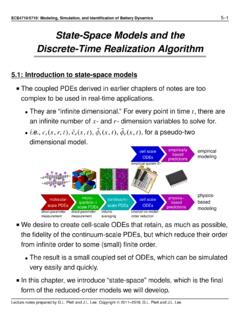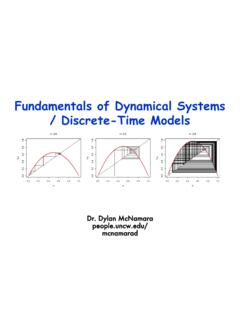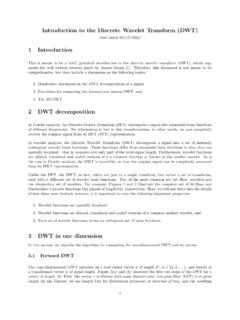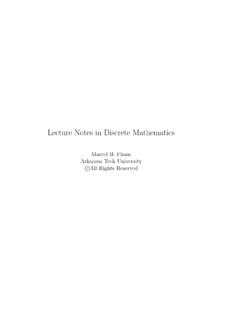Transcription of Lecture 11: Discrete-time Fourier transform
1 TransformThe Discrete-time Fourier transform has essentially the same properties asthe continuous- time Fourier transform , and these properties play parallelroles in continuous time and discrete time . As with the continuous- time Fourier transform , the Discrete-time Fourier transform is a complex-valued func-tion whether or not the sequence is real-valued. Furthermore, as we stressedin Lecture 10, the Discrete-time Fourier transform is always a periodic func-tion of fl. If x(n) is real, then the Fourier transform is corjugate symmetric,which implies that the real part and the magnitude are both even functionsand the imaginary part and phase are both odd functions. Thus for real-valuedsignals the Fourier transform need only be specified for positive frequenciesbecause of the conjugate symmetry. Whether or not a sequence is real, speci-fication of the Fourier transform over a frequency range of 27r specifies it en-tirely. For a real-valued sequence, specification over the frequency rangefrom, for example, 0 to a is sufficient because of conjugate time -shifting property together with the linearity property plays akey role in using the Fourier transform to determine the response of systemscharacterized by linear constant-coefficient difference equations.
2 As withcontinuous time , the convolution property and the modulation property are ofparticular significance. As a consequence of the convolution property, whichstates that the Fourier transform of the convolution of two sequences is theproduct of their Fourier transforms, a linear, time -it variant system is repre-sented in the frequency domain by its frequency response. This representa-tion corresponds to the scale factors applied at each frequency to the Fouriertransform of the input. Once again, the convolution property can be thoughtof as a direct consequence of the fact that the Fourier transform decomposesa signal into a linear combination of complex exponentials each of which is aneigenfunction of a linear, time -invariant system. The frequency response thencorresponds to the eigenvalues. The concept of filtering for Discrete-time sig-nals is a direct consequence of the convolution modulation property in discrete time is also very similar to that incontinuous time , the principal analytical difference being that in discrete timethe Fourier transform of a product of sequences is the periodic convolution11-1 Signals and Systems11-2rather than the aperiodic convolution of the individual Fourier modulation property for Discrete-time signals and systems is also veryuseful in the context of communications.
3 While many communications sys-tems have historically been continuous- time systems, an increasing numberof communications systems rely on Discrete-time modulation techniques. Of-ten in digital transmission systems, for example, it is necessary to convertfrom one type of modulation system to another, a process referred to as trans-modulation, and efficient implementation relies on the modulation propertyfor Discrete-time signals. As we discuss in this Lecture , another important ap-plication of the modulation property is the use of modulation to effect a high-pass filter with a lowpass filter or vice Lecture concludes our discussion of the basic mathematics of Four-ier series and Fourier transforms; we turn our attention in the next severallectures to the concepts of filtering, modulation, and sampling. We concludethis Lecture with a summary of the basic Fourier representations that we havedeveloped in the past five lectures, including identifying the various continuous- time Fourier series is the representation of a periodic con-tinuous function by an aperiodic discrete sequence, specifically the sequenceof Fourier series coefficients.
4 Thus, for continuous- time periodic signalsthere is an inherent asymmetry and lack of duality between the two contrast, the continuous- time Fourier transform has a strong duality be-tween the time and frequency domains and in fact the Fourier transform ofthe Fourier transform gets us back to the original signal, time -reversed. Indiscrete time the situation is the opposite. The Fourier series represents a pe-riodic time -domain sequence by a periodic sequence of Fourier series coeffi-cients. On the other hand, the Discrete-time Fourier transform is a representa-tion of a Discrete-time aperiodic sequence by a continuous periodic function,its Fourier transform . Also, as we discuss, a strong duality exists between thecontinuous- time Fourier series and the Discrete-time Fourier ReadingSection , Properties of the Discrete-time Fourier transform , pages321-327 Section , The Convolution Property, pages 327-333 Section , The Modulation Property, pages 333-335 Section , Tables of Fourier Properties and of Basic Fourier transform andFourier Series Pairs, pages 335-336 Section , Duality, pages 336-343 Section , The Polar Representation of Discrete-time Fourier Transforms,pages 343-345 Section , Calculations of Frequency and Impulse Responses for LTI Sys-tems Characterized by Difference Equations, pages 345-347 Discrete-time Fourier Transform11-3 Discrete-time Fourier transform -1fX(2) ejn dU27r 2+00n=-w0x[n] <TOx[n]synthesisanalysise- jnX(i)= Re X(n) t+ jImiX(S)t= IX(2)|ei X(2) discrete -timeFourier transform .
5 [As corrected here,x[n], not x(t), hasFourier transformX(fl).JPROPERTIES OF THE Fourier TRANSFORMx [n]X(g)Periodic:X(9i) =X( +27r m)Symmetry:x[n] realRejX(w)tIX(SiZ)IImlx()4 X(W)=> x(-i2)X*(92) andsymmetry propertiesof the discrete -timeFourier [n]X(92)Signals and illustratingthe periodicity andsymmetry [n] = anu[n] O<a<1X(2)=11-ae-jQI X(W) propertiesof the discrete -timeFourier shifting:x[n-n] IFrequency shifting:ejgon x[n]Linearity:ax1[n] +bx2[n]Parseval's relation:+ 00zn=- -00Ix[n] 12 = 127r21r Rtan1 a2)X(E)X(92 -20)aX, (92) + bX2(92)fIX(2)2 dEDiscrete- time Fourier Transform11-5 CONVOLUTION PROPERTYh[n] * x[n]x[n]X(92)H(92) X()h[n] * x[n]H(M) X(M)eifon H(UZ1)H1(2)K--7I--I e I response ofa Discrete-time ideallowpass [n]IH(2)~~1I-27r -7 Signals and response ofan ideal lowpass filterand an ideal ,IIH1(n)II JK-2ir -R -c 27rH2 (2)-27r -9 i 27r---1|L I co7CQ%"L 4= t .%Ot O\~ ~e~peg i*1i+ (a)X~)(~. ~ -IDiscrete- time Fourier Transform11-7 MODULATION PROPERTYD iscrete- time :x, [n] x2[n]X1 () X2(E2- 0) dOperiodic convolutionContinuous- time :x1(t) x2(t)aperiodic response andfrequency responsefor a first-ordersystem approximatinga lowpass filter and afirst-order systemapproximating ahighpass comparison of theFourier transformmodulation propertyfor continuous timeand for discrete 2ir+00X (P) X2( -p) dp-00 Signals and (b)Impulse resons anXi"3 hn ~~ response andfrequency responsefor a first-order |_|_I___ -system approximatinga lowpass filter and afirst-order systemapproximating ahighpass filter.]
6 [Transparency ] Discrete-time Fourier Transform11-9x [n] -x [n] Mlow passh [n]high passH1(0)---IIF7II,.0-2CH2(2)II-27r77I-] of modulation of asystem impulseresponse to convertthe system from alowpass to a on thefrequency response ofmodulating theimpulse response byan alternating signchange.(- 1) " h [n]I-21r2 Signals and use of modulationto implement highpassfiltering with alowpass [n]x [n].:,cies Cc-")400 RJY'I rn3 >T~~QoIZ~OkCWL) esASo2M~rr1V 8t-00-16) I~t e %t)e04070()&y [n]y [n] CL (Iz V%,MIT OpenCourseWare Resource: Signals and Systems Professor Alan V. Oppenheim The following may not correspond to a particular course on MIT OpenCourseWare, but has been provided by the author as an individual learning resource. For information about citing these materials or our Terms of Use, visit.

















